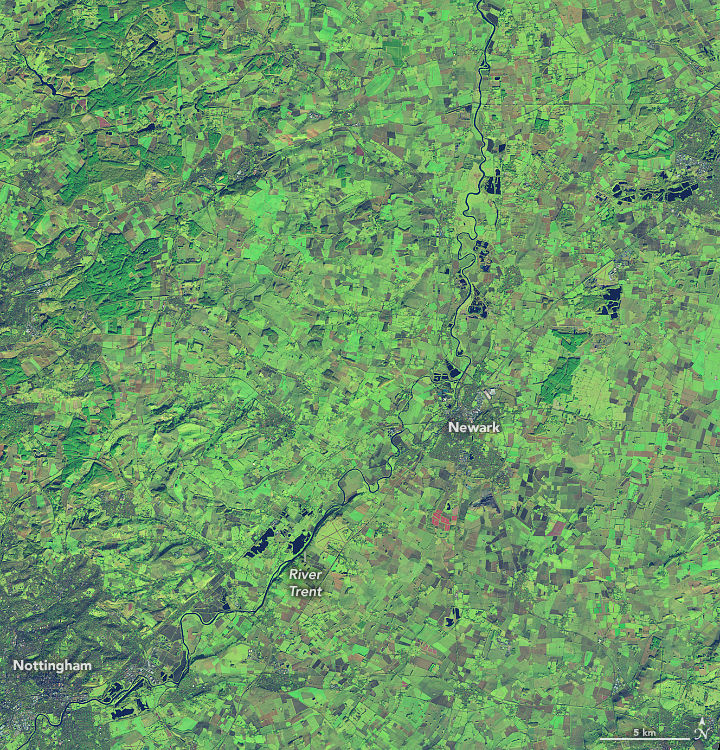

Flooding Along the River Trent
Downloads
- ukflooding_oli2_20220105_lrg.jpg (1328x1383, JPEG)
- ukflooding_oli2_20240104_lrg.jpg (1328x1383, JPEG)
Metadata
- Sensor(s):
- Landsat 9 - OLI-2
- Data Date: January 5, 2022 - January 4, 2024
- Visualization Date: January 8, 2024
Heavy rain from consecutive storms left large parts of the United Kingdom under water in early January 2024.
On January 2, a potent low-pressure system brought high winds and heavy rain to parts of the U.K. The storm, named Henk by the Met Office, delivered more than 40 millimeters of rain to parts of England and Wales in 24 hours. The rain fell on soils that were already saturated from another storm that hit the region in the last days of 2023.
Several riverside towns became swamped after rivers in central England spilled out of their banks. According to news reports, bystanders rescued two people from a car sinking in floodwater along the River Cole in Birmingham. Near Northampton, to the east, the River Nene jumped to 1.63 meters on January 3, just 1 centimeter below the record high level recorded on December 24, 2020. The storm moved east on January 3 and dumped rain and snow on France, Belgium, the Netherlands, and Germany. Rain continued to fall on saturated ground even after Storm Henk passed.
On January 4, the OLI-2 (Operational Land Imager-2) on Landsat 9 acquired this image (above right) of flooding along the River Trent near Newark and Nottingham in the East Midlands. The image is false color to emphasize the presence of water, which appears in shades of blue. More than 100 flooded properties were evacuated in Nottinghamshire County, where officials called for emergency support for affected communities.
Water levels continued to rise along the Trent after January 4. On January 6, Nottinghamshire County Council issued a new flood warning, as water levels on the River Trent had reached a record peak north of Newark, surpassing previous high levels set in 2000. As of January 8, multiple road closures remained in place across Nottinghamshire, including along major routes in Newark.
The winter storms came on the heels of one the U.K.’s hottest years on record. According to the Met Office, 2023 was the U.K.’s second warmest year on a record that goes back to 1884. Warmer air can hold more water, contributing to more frequent and intense rainstorms. Between October 1, 2023, and January 4, 2024, parts of the East Midlands, northeast England, and eastern Scotland received more than 150 percent of the 1991-2020 average rainfall for those months.
References & Resources
- BBC (2024, January 7) East Midlands flooding: Impact ‘will be felt for many months’. Accessed January 8, 2024.
- Floodlist (2024, January 4) UK — Evacuations and Rescues After Storm Henk Leaves Widespread Flooding. Accessed January 8, 2024.
- NASA Earth Observatory (2024, January 4) Storm Batters the United Kingdom. Accessed January 8, 2024.
- Nottinghamshire City Council (2024, January 4) Major incident declared in Nottinghamshire due to flooding. Accessed January 8, 2024.
- Sky News, via X (2024, January 6) BREAKING: Nottinghamshire County Council issues new flooding alert. Accessed January 8, 2024.
- UK Met Office (2024, January 2) 2023 was second warmest year on record for UK. Accessed January 8, 2024.
- UK Met Office (2024, January 5) Storm Henk. Accessed January 8, 2024.
NASA Earth Observatory images by Lauren Dauphin, using Landsat data from the U.S. Geological Survey. Story by Emily Cassidy.
This image record originally appeared on the Earth Observatory. Click here to view the full, original record.